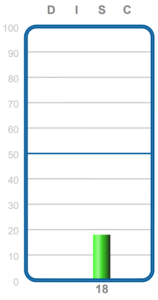Personalized classroom management strategies help meet individual student needs, fostering a positive learning environment, increasing motivation, and leading to better student performance. Understanding a student’s core DISC style provides a great framework helping each student thrive! In this blog, we’ll explore techniques for managing low steadiness students, creating a structured and results-focused environment for optimal performance.
Someone who scores below 50 in the DISC Steadiness behavioral style (green bar on the DISC graph is considered “low” in that style). The lower the score, the more the classroom strategies typically apply.
A low steadiness student may have characteristics such as being easily distracted or having difficulty maintaining focus, being impulsive, and being prone to emotional expression.. Additionally, they may have a tendency to procrastinate with completing tasks or meeting deadlines. They love variety and tend to get bored easily.
Here are some classroom management strategies to keep in mind for you students who have a low influencing behavioral style:
Provide a flexible and dynamic environment.
Low steadiness students tend to thrive in environments that are flexible and dynamic, so be open to changes in plans and activities.
Provide opportunities for movement and hands-on activities.
Low steadiness students tend to have a lot of energy, so provide opportunities for movement and hands-on activities to channel that energy in a positive way.
Be aware of the need for variety.
Encourage creativity and experimentation.
Be open to new ideas and perspectives.
Be flexible and adaptable.
Allow for group work and small-group discussions.
Provide them with opportunities to take on different roles.
These strategies aim to provide an exciting and fun learning environment that takes into account the individual needs of low steadiness students and encourages them to take responsibility for their learning and behavior. It also provide opportunities for positive reinforcement and recognition to build their motivation and self-esteem.
Note: It’s important to note that the DISC assessment is just one tool used to understand and describe behavior, and it should not be used to label or judge individuals. Each person is unique and may exhibit a combination of different behavioral traits. Additionally, behavior can change depending on the situation and context. Therefore, it is essential to use the information from the DISC assessment as a starting point for understanding and communication, not as a means of making judgments or assumptions about a person’s character or abilities.


